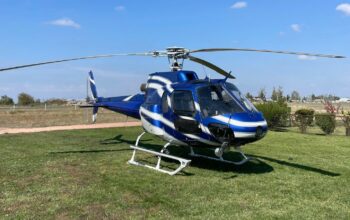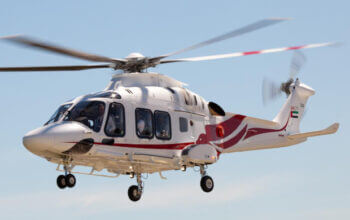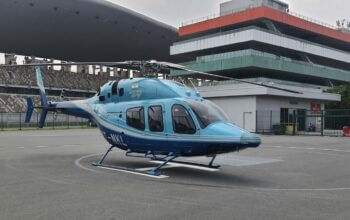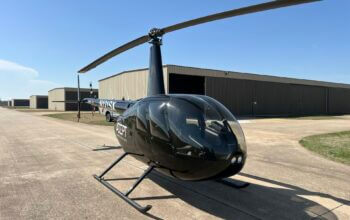Estimated reading time 4 minutes, 34 seconds.
An RCMP-operated FLIR SkyRanger R60 surveillance drone was operating in metres instead of feet when it collided with an RCMP Air Services AS350 B3 helicopter on Feb. 6. The drone was flying at 355 feet (108 metres) above ground level (AGL) at the time of the incident, while the helicopter was also flying low (below 500 feet AGL); use of the metric system to measure the drone’s altitude “was a contributing factor to the incident,” the RCMP said.

The helicopter and drone were taking part in policing activities during the Wet’suwet’en protests against the Coastal GasLink pipeline, 24 nautical miles southwest of Houston, B.C. A second RCMP-operated drone was also part of the patrol flight, but was not involved in the collision.
While the collision occurred earlier this year on Feb. 6, it was not reported in the Civil Aviation Daily Occurrence Reporting System (CADORS, a Transport Canada system that provides initial information on incidents with Canadian-registered aircraft) until June 3.
The CADORS report classified the occurrence as a mid-air collision, which resulted in initial vibration when the drone impacted the helicopter. “The pilot completed a precautionary landing on a road without further incident,” the report states. None of the three people on board the helicopter was injured.
The collision caused damage to both the helicopter and the drone.
“Maintenance staff found damage primarily to the [helicopter’s] main rotor blades along with superficial damage on the tail boom and tail rotor,” the CADORS report states. “The effected components were removed as per the maintenance manual for repairs or overhaul as required. The RPAS [remotely piloted aircraft system, or drone] was destroyed.”
Following the incident, the RCMP confirmed in an email to Skies that it hired a Super Puma helicopter operated by Coldstream Helicopters to airlift the AS350 from the road site where it made a forced landing. The cost of hiring the Super Puma was just over C$83,000.
The AS350 helicopter has been out of commission for repairs since the incident occurred in early February, and is expected to return to service in the coming days, the RCMP said.
To prevent a similar incident from happening in the future, the RCMP said “updated pre-flight checklists have been provided to RCMP RPAS pilots to confirm altitude display settings on their systems. Updated guidance was provided directing that RCMP RPAS will not be in the air at the same time as an RCMP aircraft.”
However, in situations where both types of air assets are necessary, “RCMP RPAS will fly below 300 feet [91 metres] AGL, and RCMP aircraft will fly above 500 feet [152 metres] AGL,” the RCMP said.
Roughly a week after the RCMP incident, a similar collision occurred where a drone and an AS350 helicopter collided mid-air at an off-road truck race in Southern California. The helicopter was performing aerial filming at the event; the FAA confirmed that it had not established a temporary flight restriction over the races.
Even when drone and helicopter pilots are operating in known proximity to one another, these particular incidents show there is still potential for such collisions to occur.









That is what happens with you go with feet in the air, nautical miles, and probably a “pint”. Expect more of these in the future. BTW: snow in June?!
Very sad that RCMP blame the use of metres when they should blame the continued use of feet.
Feet are the problem. The world is metric and metres are the standard. I hope the whole feet based airline industry goes bankrupt. That will end once and for all having obsolete units forced on us.
Another reason why we should stick to one system of measurement. We should do away with imperial measures to avoid confusion between the measuring systems that we use in Canada.
Drones should still be banned from general public sale!
Surely it was the use of the obsolete imperial system to measure the helicopter’s altitude that was the real “contributing factor to the incident.”
Really? Blaming the metre? How pathetic. How long is the world going to be in the death grip of the recalcitrant lunkheads who can’t wrap their heads around the international metre and insist on using a dead king’s lower extremity for a unit of measure?
Regulators worst case scenario and nobody died? How does this fit into their risk assessments?
Drone pilots fault 100 percent……..
No excuse for putting manned aviation in danger at any time..
Learn your craft or do something else
Just some information for the public.
If this were my aircraft or any other aircraft that an insurance company would be doing a claim on, there would not be another aircraft being used to lift a damaged aircraft from a road, this is absolutely absurd with us tax payers paying for it. Although if the machine was in the bush it would have been flown usually to the closest road with a appropriate aircraft, not a Super Puma. This is equivalent to getting a lowbed to transport a smart car.
Metres or feet is a moot point. The real issue is a drone operator not knowing what his/her equipment was calibrated in. As for the Super Puma, yes, massive overkill on the taxpayer’s dime. The ‘350 should’ve been trucked out. It’s also interesting to note that Coldstream Helicopters website shows that they also operate Bell 212’s which can sling 1400kgs. More than enough to lift a ‘350 with the blades removed and likely substantially cheaper than the SP.
amateur night with the RCMP